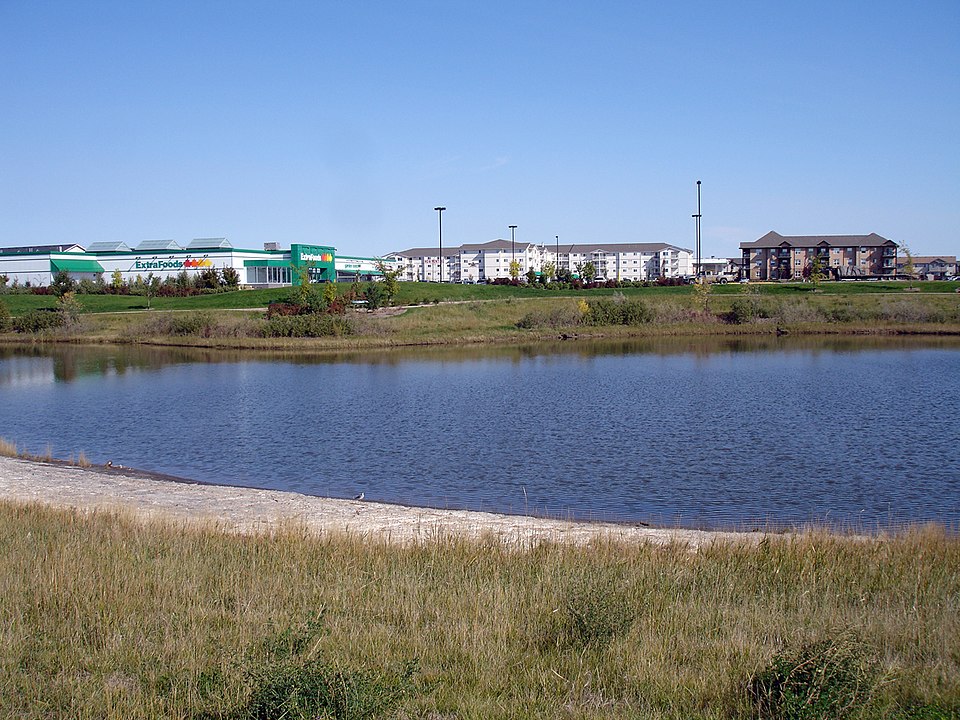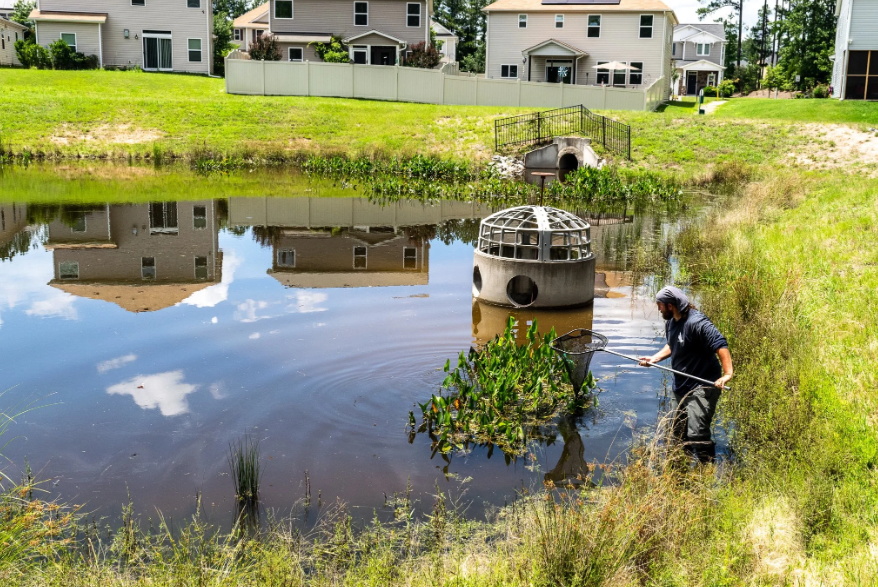Retention Ponds: Stormwater Solutions and Safety Concerns
Retention ponds, also known as wet ponds, wet detention basins, or stormwater management ponds, are artificial bodies of water designed to permanently hold a pool of water while also having additional capacity to temporarily store excess stormwater runoff during heavy rainfall events.
What are Retention Ponds?
- They are engineered basins with a permanent pool of water, unlike "detention ponds" (or "dry ponds") which are typically dry between rain events and only fill up temporarily.
- They often have vegetated perimeters and can be designed to blend into the surrounding landscape, sometimes even appearing as natural water features.
- They are connected to stormwater drainage systems, receiving runoff from impervious surfaces like roads, parking lots, and rooftops.

What is their use?
Retention ponds serve multiple crucial purposes, especially in developed areas where natural water absorption is diminished:
- Flood Prevention and Stormwater Management (Quantity Control):
- This is their primary function. During heavy rainfall, they collect and temporarily store a large volume of stormwater runoff.
- By holding this water, they prevent it from rapidly overwhelming downstream drainage systems, rivers, and streams, thereby reducing the risk of flooding and erosion.
- The water is then slowly released at a controlled rate through outlet structures (like pipes or weirs) once the immediate flood risk has passed, mimicking the natural flow of water before development.
- Water Quality Improvement (Pollutant Removal):
- As stormwater runoff flows into the pond, it often carries pollutants like sediment, debris, chemicals (from fertilizers, oil, etc.), and other contaminants from urban and agricultural areas.
- Retention ponds act as natural filters:
- Sedimentation: The permanent pool of water allows suspended sediments and larger particles to settle at the bottom.
- Biological Uptake: Aquatic vegetation (plants within and around the pond) and biological activity within the water help absorb and break down nutrients (like nitrogen and phosphorus) and other soluble pollutants.
- This process significantly improves the quality of the water before it is released into downstream waterways.
- Erosion Control:
- By slowing down the flow of stormwater and controlling its release, retention ponds help prevent erosion of soil and stream banks, both within the pond's vicinity and further downstream.
- Habitat Creation and Biodiversity:
- Well-designed retention ponds with diverse native vegetation can create valuable aquatic and riparian habitats for various wildlife, including birds, amphibians, insects, and fish. This contributes to local biodiversity.
- Aesthetic and Amenity Value:
- When properly designed and maintained, retention ponds can be aesthetically pleasing features in communities, parks, and golf courses.
- They can enhance the visual appeal of a development and sometimes even offer recreational opportunities (e.g., fishing, non-motorized boating, if permitted and safe).
- They can even increase property values in residential areas.
In essence, retention ponds are vital components of modern infrastructure, helping to manage the impact of urbanization on natural water cycles by addressing both the quantity and quality of stormwater runoff.
While retention ponds are designed for essential environmental benefits, they do pose several potential dangers, which is why safety measures and awareness are crucial. Here's why retention ponds can be dangerous:
- Drowning Risk (Especially for Children and Pets):
- Steep, Slippery Slopes: The banks of retention ponds are often constructed with steep, sometimes muddy or vegetated slopes that can be very difficult to climb out of if someone falls in.
- Deep Water: While the permanent pool depth varies, they can be deep enough to pose a significant drowning risk, even for adults who aren't strong swimmers.
- Sudden Drop-Offs: The edges might have sudden drop-offs, making it hard to gauge depth.
- Cold Water: Even on warm days, the water can be cold, leading to hypothermia and muscle cramps.
- Hidden Obstacles: Debris, plants, or underwater structures can snag clothing or entangle a person.
- Ice: In winter, the ice on retention ponds is often thin and unstable due to fluctuating water levels, varying depths, and water flow, making it extremely dangerous to walk or play on.
- Water Quality Hazards:
- Pollutants: Retention ponds are designed to collect stormwater runoff, which often contains pollutants like chemicals (pesticides, fertilizers, oil, antifreeze), trash, and animal waste. Contact with this water can cause skin irritation, illness, or infections if ingested.
- Harmful Algal Blooms (HABs): Especially in warmer months, nutrient-rich runoff can lead to the proliferation of cyanobacteria (blue-green algae), which can produce toxins harmful to humans and animals if swallowed or in prolonged contact. These blooms often look like green paint or scum on the water's surface.
- Bacteria and Pathogens: Fecal matter from animals can introduce harmful bacteria (like E. coli) or viruses.
- Hidden Currents and Outlets:
- Inflow and Outflow Pipes: Water enters and exits the pond through pipes and culverts. These can create strong, often hidden, currents that can pull someone underwater or trap them against a grate.
- Vortexes: As water drains, particularly during or after heavy rain, dangerous vortexes can form over outlet structures.
- Wildlife Risks:
- While retention ponds can create habitats, they can also attract wildlife that might be dangerous if approached, such as snakes, snapping turtles, or aggressive birds (e.g., geese that might charge if their nests or young are threatened).
- Lack of Visibility:
- The water in retention ponds can often be murky, obscuring hidden dangers like drop-offs, submerged debris, or animals.

Safety Recommendations:
Given these dangers, it's crucial for communities with retention ponds to implement safety measures and for individuals to exercise caution:
- Fencing: Secure fencing around ponds, especially in residential areas, is highly recommended to prevent accidental entry.
- Warning Signs: Clear signage indicating "Danger - Deep Water," "No Swimming," "Thin Ice," and "Keep Out" is essential.
- Education: Educating children and adults about the dangers of retention ponds.
- Supervision: Never allow children or pets to play unsupervised near retention ponds.
- Avoid Retrieval: Do not attempt to retrieve items (e.g., toys, balls) that fall into a pond; contact local authorities or pond management.
- Stay Away from Edges: Keep a safe distance from the pond's edge, as slopes can be slippery.
- Report Concerns: Report any missing fencing, broken signs, or unsafe conditions to local authorities or homeowners' associations.
In summary, while retention ponds are valuable for stormwater management, their inherent design and purpose mean they should always be treated with caution, similar to any other body of water.
⚠️ Risk Profile: Who’s Most Affected?
A 2004–2020 national study identified 265 drowning deaths in retention ponds across the U.S. (PubMed)
- Children ages 1–4 accounted for ~ 60% of these incidents.
- Among children under 5, over 80% of deaths were linked to neglect, lack of supervision, or hazardous exposure.
- Supervisors were reported absent or impaired in ~50% of cases, and even with children in sight, ~30% still drowned (PubMed, Wikipedia).
- Just ~33% of retention ponds had fences, and only ~18% had warning signs (PubMed).
📌 Notable Fatal Incidents
- Greenwood, Indiana (June 2022)
Two girls—age 11 and 13—drowned in a neighborhood retention pond. They were found after playing in the water and failing to resurface.
- Jacksonville, Florida (2021)
Multiple young children, including a 4-year-old with autism and a 5-year-old, drowned at separate times in neighborhood ponds. These cases spurred safety campaigns and calls for mandatory fencing and signage.
- Fort Myers, Florida (Dec 2024)
A 7-year-old autistic boy drowned in a pond. Only ~5% of ponds in Florida reportedly had secure fencing, prompting advocacy for state-level safety rules.
- Dorchester County, South Carolina (Sept 2023)
A toddler died after being found in a pond at an apartment complex. It followed another fatality weeks earlier. Homeowners called for barriers, surveillance, and design changes.
- Vacation tragedy in Horry County, SC (June 2025)
A 5-year-old died after being pulled from a retention pond near Surfside Beach. Neighbors again cited the lack of fencing as a preventable risk factor.
- West Jefferson, Ohio (June 5, 2025)
An SUV carrying two children and three adults crashed into a retention pond. A 27-year-old woman and a 3-year-old child drowned; three others survived.
🚗 Other Types of Accidents
- Vehicle submersions into retention ponds—though less common—have occurred in Florida, often requiring emergency water rescues.
- In Ohio, a serious multi-fatality crash involved a retention pond in 2025.
🔍 Common Patterns & Contributing Factors
|
Risk Factor
|
Key Issues
|
|
Young age / disabilities
|
Water attracts children, especially with autism
|
|
Lack of supervision
|
Almost half of incidents involve absent/impaired care
|
|
Inadequate barriers
|
~66% of retention ponds lack fencing
|
|
Absence of warning signage
|
~82% are not labeled as hazardous
|
|
Steep slopes and murky water
|
Makes escape and rescue difficult
|
|
Vehicle accidents
|
Cars may slip into ponds near roads or driveways
|
✔️ Prevention & Safety Measures
- Fencing and gate access control, especially in residential or high child-traffic areas.
- Warning signage to discourage trespassing or entry.
- Design interventions such as shallower ledges and vegetation zones near water.
- Community awareness campaigns and educational outreach.
- Legislative actions: e.g. proposed laws in Wisconsin would require standardized fences and safety signage near high-density development ponds (WINK News, PMC, WJXT, Action News Jax, https://www.weau.com, First Coast News).
Key Takeaways
- Retention ponds, while common in modern development, pose a real drowning risk, especially to young children.
- Children under 5 and those with autism are particularly vulnerable.
- Most tragic incidents are preventable with basic safety infrastructure and oversight.
- The role of developers, HOAs, and local governments is crucial in implementing protective measures.
If you're concerned in your area
Consider:
- Checking retention ponds near your home or neighborhood.
- Asking local councils about safety features.
- Supporting rules or community efforts for fencing, signage, or design changes.
If you’d like statistics by state or city, or guidance for your own locality, just let me know—I’m happy to look up more specific info.

